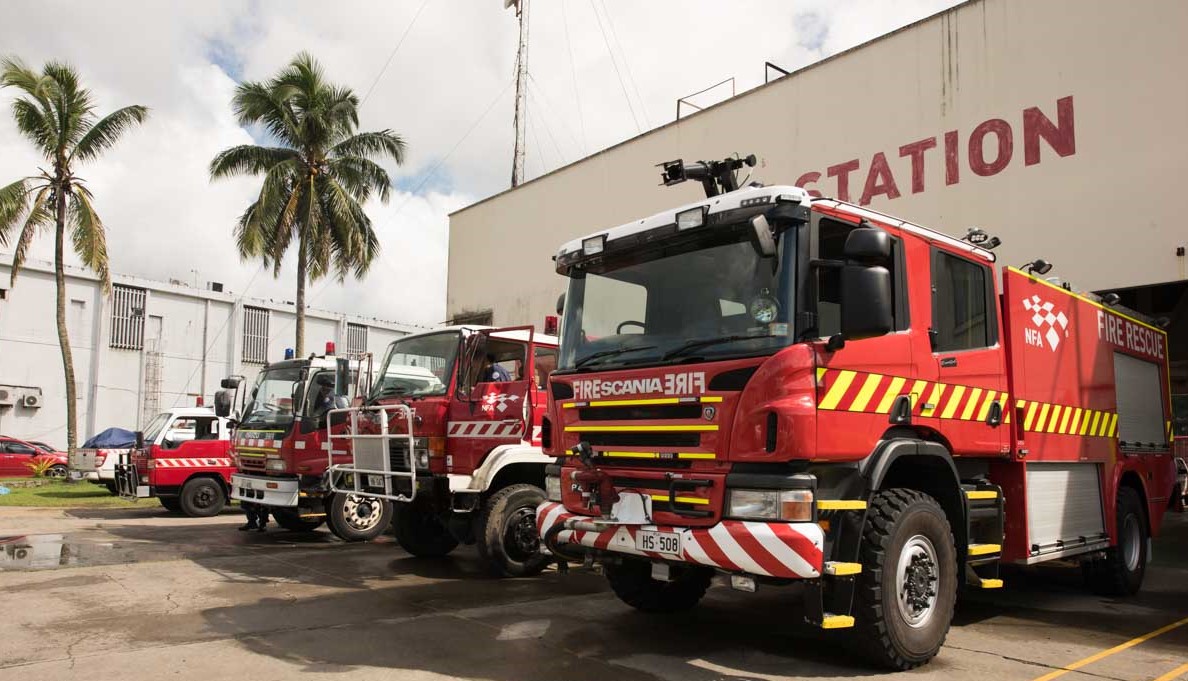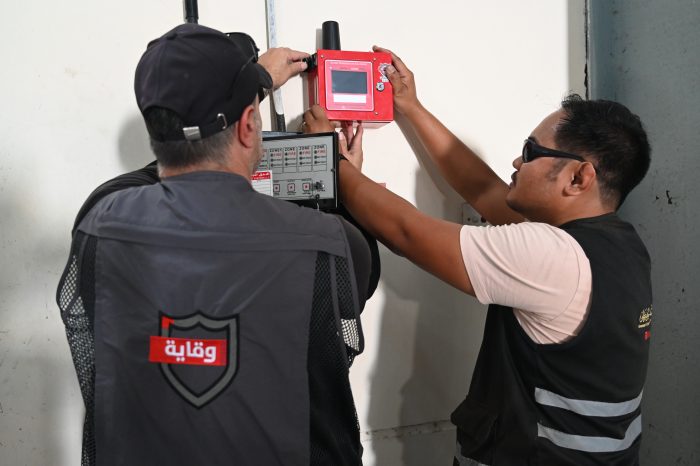Fiji is an archipelago of over 300 islands spread across roughly 1,000,000 square miles of the South Pacific. It is home to approximately 900,000 people, with major urban centres in Suva, Lautoka, and Nadi. The National Fire Authority (NFA) is responsible for fire protection across this dispersed nation, which poses significant logistical challenges. Fire stations and the communities they protect are scattered over multiple islands, making centralized monitoring and maintenance of fire alarm systems difficult under conventional methods.
Legacy system
Until recently, Fiji’s fire alarm monitoring relied on an aging 3G-based system with physical services managed by the NFA. This legacy infrastructure was becoming unreliable with limited vendor support. As 3G networks were phased out and the system aged, the NFA faced increasing risks of communication failures in emergency alarm transmission. Additionally, any configuration changes or diagnostics on Alarm Signalling Equipment (ASE) required technicians to travel on-site – a costly and time-consuming process given Fiji’s geography. Recognizing these challenges, the NFA sought a modern solution that would improve reliability, provide real-time remote oversight, and reduce the need for physical servicing trips to distant locations.
Challenge
Remote monitoring needs: The primary challenge was to enable reliable, nation-wide monitoring of fire alarms across Fiji. The NFA needed a platform that could connect hundreds of sites – from dense urban areas to small remote communities – and instantly alert central dispatch of any fire alarms or system faults. The solution had to work over Fiji’s existing telecommunications infrastructure and remain resilient even in areas with spotty connectivity. Dual-path communication was desired to ensure redundancy, meaning if one network path went down, another could automatically take over.
Outdated technology and support: The existing 3G alarm system was not only nearing end-of-life, but also lacked modern capabilities like over-the-air updates or remote configuration. NFA operators had minimal real-time visibility into the status of field devices; troubleshooting often meant dispatching a technician to inspect hardware on-site. Given the vast distances and inter-island travel required, this was untenable for timely maintenance. Moreover, the incumbent service vendor’s limited support meant the NFA sometimes waited long periods for fixes or upgrades. These shortcomings heightened the urgency for a new solution that could leverage current-generation 4G/LTE networks, cloud computing, and remote management to vastly improve operational efficiency.
Integration and training: Another challenge was ensuring any new system would integrate with the NFA’s planned Computer-Aided Dispatch (CAD) system for seamless emergency response. Fire alarm alerts needed to flow directly into the dispatch centre software, so firefighters could be mobilized without delay. Additionally, adopting a new technology platform would require training NFA personnel and updating standard operating procedures. The NFA sought a partner that could not only deliver the technology but also provide comprehensive training and ongoing support to its teams across Fiji.
Solution
Tender and deployment: In 2024, after a competitive government tender process, Transdigital was selected to implement a country-wide fire alarm signalling upgrade for Fiji NFA. The project involves deploying 500 new ASE units (Alarm Signalling Equipment) across Fiji’s islands, all connected to Transdigital’s cloud-based TransIoT Fire platform. Installation began in late 2024, starting with high-priority sites in Suva and other major towns, and is scheduled for completion by late 2025. Each ASE unit either uses a dual cellular data connection or an Ethernet link (where available) to transmit signals, thereby covering locations with differing infrastructure. Transdigital’s solution was engineered to address Fiji’s unique needs, providing reliable alarm communication and full remote management capabilities.
Modern ASE devices: The Transdigital ASE (such as the TD2020 unit shown) is a next-generation alarm communicator that can interface with local fire panels and detectors. These units support dual-path connectivity – they are equipped with multi-network 4G modems and can fall back between Fiji’s two main telecom providers, Vodafone and Digicel, to maximize coverage. In many installations, one communication path runs over the cellular network while a secondary path can utilize broadband (IP over Ethernet) if available. This ensures that even if one network is down, the alarm signal still gets through. The devices are also designed for longevity and easy maintenance; they support over-the-air firmware upgrades and remote configuration, meaning technicians can update settings or troubleshoot issues via the cloud without needing a site visit. This modular, resilient hardware forms the backbone of NFA’s upgraded alarm system.
TransIoT Fire cloud platform: At the core of the solution is Transdigital’s TransIoT Fire, a secure cloud-based software platform for monitoring and managing the ASE network. All alarm signals and device status information are reported in real-time to this platform, which NFA personnel can access through a web-based dashboard. Using TransIoT Fire, operators have a live view of every connected alarm unit across Fiji – they can see alerts, supervisory signals, and the health/status of each device instantly. The platform also enables remote configuration and diagnostics: if an ASE at a remote location triggers a trouble alert, technicians in Suva can investigate the issue through the cloud, potentially resolving it remotely or determining if a site visit is needed. This dramatically reduces the response time for maintenance. The TransIoT Fire system is built on a robust cloud infrastructure (hosted on AWS) with high availability, and it operates over a private VPN with encryption and multi-factor security for data integrity. For the NFA, this means a scalable, nation-wide monitoring system that can grow with future needs and remains accessible from any location with internet access.
Training and support: Transdigital provided comprehensive training to NFA’s teams during the rollout. Workshops and hands-on sessions were conducted for fire officers, control room staff, and technicians, demonstrating how to use the TransIoT Fire dashboard, interpret device alerts, and perform remote diagnostics. NFA personnel quickly learned to navigate the new system – for example, how to acknowledge alarms on the screen, run remote tests on an ASE, or update configuration settings for a particular site. The training emphasized the shift from the old way of working (physical checks and phone reports) to the new paradigm of proactive digital monitoring. To ensure a smooth transition, Transdigital’s support engineers worked closely with NFA staff during the initial installations. The partnership is ongoing: Transdigital’s team continues to provide remote support and will assist NFA with any technical queries throughout the deployment period. This knowledge transfer and support structure empower the NFA to get the most out of their new system from day one.
Key components of the solution include:
- TransIoT Fire Cloud Platform: A scalable, web-based monitoring system that centralizes all Fiji-wide fire alarm signals in one dashboard, accessible 24/7 by NFA. It offers real-time alerts, remote device management, and integration with other systems.
- Modern ASE Units (500+): New alarm signalling devices installed at sites across Fiji, replacing the old 3G units. They support dual SIM/dual-network connectivity and can use both cellular and Ethernet paths for communication, ensuring high reliability.
- Dual Telecommunications Paths: Utilizing both Vodafone and Digicel networks for primary and backup connectivity. This dual-path approach guarantees that even if one carrier has an outage or a coverage gap in a particular area, the alarm signal will still transmit via the alternate network.
- Remote Configuration & Diagnostics: NFA technicians can remotely access each ASE to perform diagnostics, push firmware updates, and adjust settings over-the-air. This reduces the need for on-site maintenance visits, which is especially beneficial for islands that are hours away by boat or plane.
- Training and Ongoing Support: Transdigital delivered on-site training for NFA operators and continues to provide remote support. Detailed user guides and a period of parallel operation (outgoing and new systems) helped users gain confidence. The NFA now has local experts proficient in the new system, backed by Transdigital’s support for any advanced assistance.
Results
Improved visibility and responsiveness: Since the introduction of Transdigital’s solution, Fiji NFA now enjoys unprecedented visibility into its fire alarm network. At headquarters and regional command centres, officials can see the status of every protected premises at a glance. All alarms, faults, and supervisory signals are logged and displayed in real-time, which means the NFA can respond to issues faster. For example, if a fire alarm in a remote town goes off, dispatchers immediately see it on TransIoT Fire and can verify its details, then quickly dispatch the nearest fire crew. Likewise, if a device’s connection is lost, NFA’s technical team is alerted instantly and can take action before it becomes a bigger problem. This proactive monitoring capability has reduced the likelihood of missing critical alarms and has tightened NFA’s emergency response loop across the country.
Operational efficiencies: The cloud-based system has significantly streamlined NFA’s operations. Remote configuration and diagnostics have cut down on unnecessary site visits – many issues that would have once required a technician to travel to an island can now be diagnosed and often resolved from the main control room. This not only saves time and travel costs but also keeps alarm systems up and running with minimal downtime. Early in the rollout, NFA reported that several minor faults (such as misconfigured settings and false trouble signals) were corrected remotely via TransIoT Fire’s interface, avoiding delays that would have occurred waiting for a technician’s trip. Additionally, the use of dual telecom paths has virtually eliminated communication outages; even during a recent network disruption in a rural area, the backup connection ensured the alarm signals still got through, where previously they might have been lost. The redundancy and reliability built into the new system give the NFA and the communities they serve greater confidence that alarms will be received without fail.
Enhanced collaboration and support: With Transdigital’s ongoing support, the NFA has built up local expertise in managing the new system. Regular check-in meetings between NFA’s IT officers and Transdigital’s team have helped optimize the platform’s performance for Fiji’s environment (for instance, fine-tuning alert thresholds to local conditions). The training provided has enabled NFA staff to take charge of day-to-day monitoring and basic troubleshooting, calling on Transdigital only for advanced support. This collaboration ensures that the technology transfer is sustainable. Furthermore, the integration with the dispatch system has improved inter-departmental workflows – fire alarm alerts are now an integral part of the emergency response process, alongside emergency calls. This means faster decision-making and better allocation of resources during incidents, as all information converges in one place.
Nationwide impact and future outlook: Even though the deployment is still underway (with full completion expected by end of 2025), the Fiji NFA is already experiencing the positive impact of the upgrade. Once all 500 ASE units are installed and commissioned, virtually every commercial or public building with a fire alarm in Fiji will be connected to the TransIoT Fire platform. This unified, country-wide alarm monitoring network is one of the first of its kind in the Pacific region, positioning Fiji as a leader in fire safety innovation. The NFA can now confidently expand services to more remote communities, knowing the supporting technology is robust. In the long term, the cloud platform also opens doors for future enhancements – such as analytics on alarm patterns, integration of additional sensor types, or even mobile notifications to building owners – further improving fire prevention and response.
By partnering with Transdigital, the Fiji National Fire Authority has transformed its fire alarm monitoring capabilities, overcoming the challenges of island geography through a cutting-edge, cloud-enabled solution. The result is a safer Fiji, with fire services able to monitor and respond to emergencies more effectively than ever before.


Weqayah – The Emirate of Ajman
The United Arab Emirates is promoting a nationwide scheme to universally improve public safety. A chief concern is fire, a frequent occurrence in the built up metropolitan areas. The Emirate of Ajman comprised of some 30,000 buildings in a high density mix of commercial, industrial and residential. Ajman evaluated several ATE systems in other projects before selecting Transdigital.